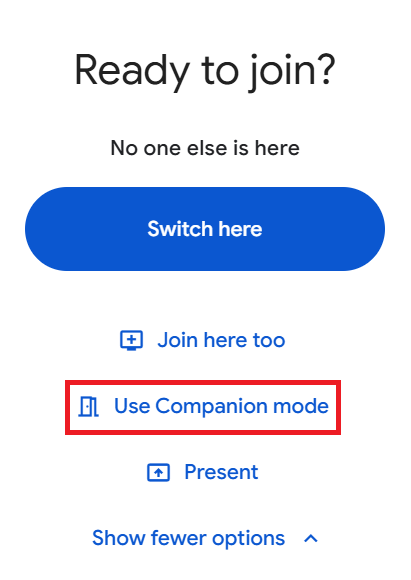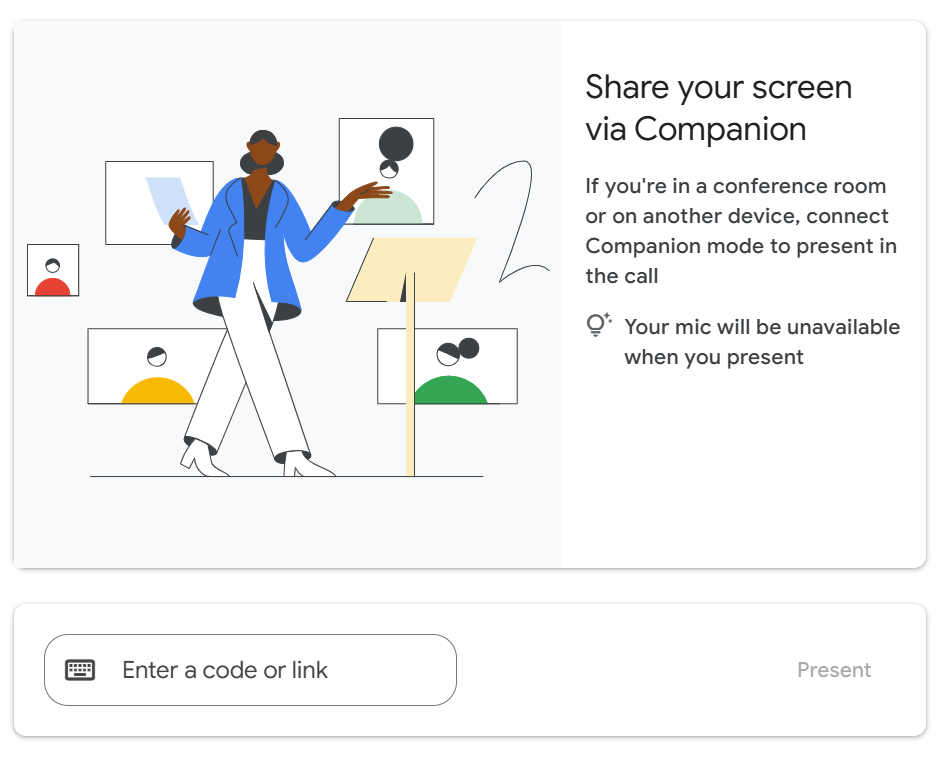Google Meet Companion Mode: How It Works
July 10, 2024
July 10, 2024
September 19, 2025
September 19, 2025
Successful hybrid meetings mean everyone can participate equally in discussions, access interactive features, and contribute to decisions regardless of their location.
Luckily, Google Meet's Companion Mode allows meeting room attendees to join a Google Meet call on a secondary device while using meeting room hardware for audio and video.
This article explains how Companion Mode works, its key features, benefits, and practical applications, and provides tips for maximizing its use in hybrid meetings to ensure the perfect meeting experience.
What is Companion Mode in Google Meet?

Google Meet's Companion Mode enhances hybrid meetings where some meeting participants gather in a conference room while other participants join remotely. This feature ensures collaboration equity by giving everyone access to the same Google Meet features, regardless of how they join the video meeting.
Companion Mode allows users to join meetings on a secondary device, such as:
- Laptops and desktop computers for full feature access
- Tablets (iPads and Android tablets) for portable interaction
- Mobile phones for quick engagement on the go
- Foldable devices for flexible screen configurations
Your microphone and video are automatically muted on the Companion Mode device to prevent audio feedback. This setup enables interaction with interactive features, while the main room uses meeting room hardware for audio quality.
Key features and functionalities
- Interactive Communication: Use your Companion Mode device to participate in chat discussions and polls without disrupting the meeting room's primary audio and video setup.
- Screen Sharing: Present content directly from your secondary device to make presentations more flexible.
- Engagement Tools: Raise your hand virtually or use emoji reactions to provide instant feedback without interrupting the active speaker.
- Accessibility Features: Enable captions on your personal device and participate in Q&A sessions using familiar interfaces.
- Room Check-in: Connect your name to the conference room tile, ensuring your personal video tile appears when you raise your hand and making it clear to other meeting participants who is speaking.
💡 Pro tip: Want seamless note-taking during your hybrid meetings? Try Tactiq for automatic transcription and AI summaries with Google Meet – it works perfectly alongside Companion Mode.
Google Meet Proximity Detection

Image from Google
Google Meet now supports ultrasound-based proximity detection. When a laptop nears Google Meet hardware, it will automatically highlight "Use Companion mode", replacing the "Join now" option.
This automatic room check-in via proximity detection uses your laptop's microphone to detect an ultrasound signal from the conference room hardware. The system intelligently guides you to the best joining option.
When you join using the highlighted Companion Mode button, you'll also be automatically checked into the correct meeting room. This means your name appears on the conference room tile immediately, and other meeting participants can easily identify who is speaking during the Google Meet meeting.
Why Use Companion Mode?
Here are key reasons why Companion Mode has become essential for hybrid meetings:
Overcoming meeting room hardware limitations
Most meeting room hardware focuses on audio and video but lacks individual user controls. Companion Mode fills this gap by giving each person access to features like breakout rooms, polls, and Q&A sessions that aren't available on shared conference room systems. This means you can participate fully without being limited by your physical location.
Creating seamless presenter experiences
When you need to present from a meeting room, Companion Mode lets you control your presentation directly from your device. You can advance slides, share your screen, and monitor participant reactions simultaneously. This eliminates the need to pass devices around or rely on someone else to manage your presentation.
Enabling better meeting management for hosts
Meeting hosts can use Companion Mode to manage participants, track attendance, and moderate discussions more effectively. You can assign people to breakout sessions, monitor chat activity, and use host controls without disrupting the main room's audio setup.
Supporting accessibility needs
Companion Mode provides personalized accessibility options that meeting room hardware often can't offer. Participants can enable captions on their personal devices, adjust text size, and use familiar interfaces without affecting what others see on the main display.
How To Activate Companion Mode In Google Meet
There are several ways to activate Companion Mode in Google Meet. Here's how to get started:
Using a meeting invite

When you receive a Google Meet meeting invite, follow these steps:
- Open the email or Google Calendar event containing the meeting link.
- Click the "Join Call" button to enter the meeting's green room.
- Look for "Use Companion Mode" under the joining options.
- Click "Use Companion Mode" to join without audio or video.
- If you're in a conference room, check in to display your name on the room tile.
Using the short link (g.co/companion)

Image from Google
For quick access to Companion Mode:
- Open your web browser and visit g.co/companion.
- On the Google Meet home screen, select your scheduled meeting or enter the meeting code.
- Click "Join" to enter the meeting using Companion Mode.
- Complete room check-in if prompted to connect your name to the conference room.
Presenting using g.co/present

To present content while in Companion Mode:
- Navigate to g.co/present in your web browser.
- Choose your scheduled meeting or enter the meeting code.
- Select which screen or window to present.
- Click "Share" to start presenting your content.
- Your presentation will appear to all meeting participants while your audio remains muted.
Mobile device activation
Companion Mode is also available on mobile devices:
- Open the Google Meet app on your phone.
- Tap your scheduled meeting or enter the meeting code.
- Under your self-view, tap "Use Companion Mode".
- Check in to your meeting room when prompted.
- Access chat messages, polls, and other interactive features directly from your mobile device.
Using a tablet and foldable devices
To activate Companion Mode for Android and iOS tablets and foldables:
- Open the Google Meet app on your tablet or foldable device.
- Select your scheduled meeting or enter the meeting code.
- Tap "Use Companion Mode" from the joining options.
- Complete a room check-in to associate your name with the conference room.
- Use the split-screen view to multitask between the meeting and other apps.
How Tactiq Works with Google Meet Companion Mode

Want to get more value from your Companion Mode meetings?
Use AI tools like Tactiq to automatically capture and organize everything that happens across all your devices and interactions.
Tactiq works seamlessly with Google Meet, Zoom, and Microsoft Teams, transcribing conversations in real time without recording audio or disrupting your meeting setup.
Here's how Tactiq complements your Companion Mode meetings:
- Complete meeting capture: Automatically transcribes all verbal discussions to provide comprehensive documentation of everything spoken during your hybrid meetings.
- Smart meeting summaries: Generate AI-powered summaries that highlight key decisions, action items, and discussion points from the meeting.
- Seamless follow-up: Transform meeting content into actionable next steps and personalized recap emails for all participants, whether they joined through meeting room hardware or companion mode devices.
- Cross-platform flexibility: Use the same powerful meeting intelligence across Google Meet, Zoom, and Microsoft Teams, ensuring consistent documentation regardless of which platform your team prefers.
With Tactiq's AI workflows, your hybrid meeting insights can also sync to your existing productivity tools. While Companion Mode ensures everyone can participate equally in meetings, Tactiq ensures all that valuable interaction gets captured, organized, and turned into actionable outcomes.
Download the free Tactiq Chrome Extension today!
{{rt_cta_ai-convenience}}
Maximizing Companion Mode in Hybrid Meetings
Google Meet's Companion Mode creates hybrid meetings where both in-person and remote participants can engage fully. By using chat messages, polls, and screen sharing on secondary devices, meeting participants avoid audio feedback while accessing interactive features that meeting room hardware often lacks.
Combined with tools like Tactiq for comprehensive meeting documentation, Companion Mode ensures that hybrid meetings are both productive and inclusive.
Ready to transform your hybrid meeting workflow? Add Tactiq to your Chrome browser today.
FAQs About Google Meet Companion Mode
What is Companion Mode in Google Meet?
Companion Mode allows users to join a Google Meet call using a secondary device like a laptop, tablet, or mobile phone. It provides access to features like chat messages, polls, and Q&A sessions, while the main audio and video are managed through meeting room hardware or your primary device.
Can I use Companion Mode on mobile devices?
Yes, Companion Mode is now available on mobile devices. Google has optimized Companion Mode for Android and iOS tablets, phones, and foldable devices, making it more convenient to participate in hybrid meetings.
Does Companion Mode count towards the participant limit?
Yes, each Companion Mode connection counts towards the overall participant limit in your Google Meet meeting. Keep track of this to avoid exceeding the meeting capacity, especially in large meetings with multiple companion mode users.
How do I leave Companion Mode on Google Meet?
To exit Companion Mode, tap or click the red "Leave" button on your companion mode device. You can then rejoin the meeting with full audio and video if needed. If you were checked into a meeting room, you'll need to check in again after rejoining.
How does Tactiq enhance my Companion Mode experience?
Tactiq automatically transcribes all verbal discussions during your Companion Mode meetings and generates AI-powered summaries with key decisions and action items. This ensures you capture everything important while focusing on engaging with interactive features through your secondary device.
Companion Mode allows users to join a Google Meet call using a secondary device. It enhances participation by providing access to features like chat, polls, and Q&A, while the main audio and video are managed through primary devices.
As of now, Companion Mode is primarily designed for use on laptops and desktops. Mobile device support is limited.
Yes, each Companion Mode connection counts towards the overall participant limit. Keep track of this to avoid exceeding the meeting capacity.
Always mute the microphone on your secondary device when using Companion Mode. This prevents audio feedback and ensures a clear communication channel.
Tactiq automatically transcribes your Google Meet sessions and generates AI-powered summaries, so you never miss key points. You save time by focusing on the conversation while Tactiq captures notes and action items for easy follow-up.
Want the convenience of AI summaries?
Try Tactiq for your upcoming meeting.
Want the convenience of AI summaries?
Try Tactiq for your upcoming meeting.
Want the convenience of AI summaries?
Try Tactiq for your upcoming meeting.


_Main.jpg)






